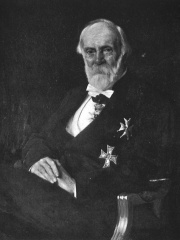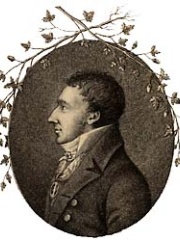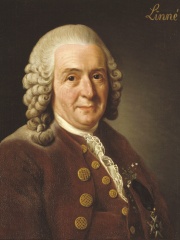
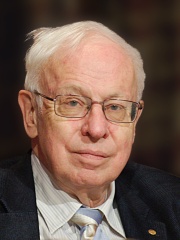
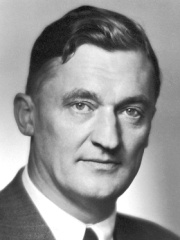
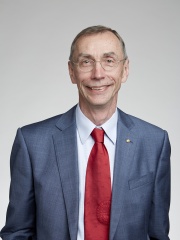
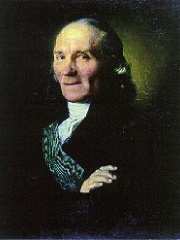
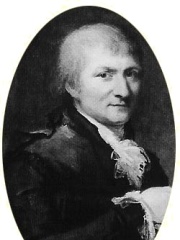
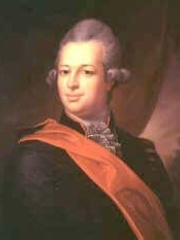
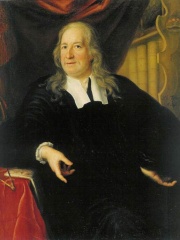
The Most Famous
BIOLOGISTS from Sweden
This page contains a list of the greatest Swedish Biologists. The pantheon dataset contains 1,097 Biologists, 31 of which were born in Sweden. This makes Sweden the birth place of the 5th most number of Biologists behind United Kingdom, and France.
Top 10
The following people are considered by Pantheon to be the top 10 most legendary Swedish Biologists of all time. This list of famous Swedish Biologists is sorted by HPI (Historical Popularity Index), a metric that aggregates information on a biography's online popularity. Visit the rankings page to view the entire list of Swedish Biologists.

1. Carl Linnaeus (1707 - 1778)
With an HPI of 90.16, Carl Linnaeus is the most famous Swedish Biologist. His biography has been translated into 182 different languages on wikipedia.
Carl Linnaeus (23 May 1707 – 10 January 1778), also known after ennoblement in 1761 as Carl von Linné, was a Swedish biologist and physician who formalised binomial nomenclature, the modern system of naming organisms. He is known as the "father of modern taxonomy". Many of his writings were in Latin; his name is rendered in Latin as Carolus Linnæus and, after his 1761 ennoblement, as Carolus a Linné. Linnaeus was the son of a curate and was born in Råshult, in the countryside of Småland, southern Sweden. He received most of his higher education at Uppsala University and began giving lectures in botany there in 1730. He lived abroad between 1735 and 1738, where he studied and also published the first edition of his Systema Naturae in the Netherlands. He then returned to Sweden where he became professor of medicine and botany at Uppsala. In the 1740s, he was sent on several journeys through Sweden to find and classify plants and animals. In the 1750s and 1760s, he continued to collect and classify animals, plants, and minerals, while publishing several volumes. By the time of his death in 1778, he was one of the most acclaimed scientists in Europe. Linnaeus has been called Princeps botanicorum (Prince of Botanists) and "The Pliny of the North". He is also considered one of the founders of modern ecology. In botany, the abbreviation L. is used to indicate Linnaeus as the authority for a species' name. In zoology, the abbreviation Linnaeus is generally used; the abbreviations L., Linnæus, and Linné are also used. In older publications, the abbreviation "Linn." is found. Linnaeus's remains constitute the type specimen for the species Homo sapiens following the International Code of Zoological Nomenclature, since the sole specimen that he is known to have examined was himself.

2. Tomas Lindahl (b. 1938)
With an HPI of 73.64, Tomas Lindahl is the 2nd most famous Swedish Biologist. His biography has been translated into 60 different languages.
Tomas Robert Lindahl (born 28 January 1938) is a Swedish-British scientist specialising in cancer research. In 2015, he was awarded the Nobel Prize in Chemistry jointly with American chemist Paul L. Modrich and Turkish chemist Aziz Sancar for mechanistic studies of DNA repair.

3. Hugo Theorell (1903 - 1982)
With an HPI of 72.50, Hugo Theorell is the 3rd most famous Swedish Biologist. His biography has been translated into 54 different languages.
Axel Hugo Theodor Theorell (6 July 1903 – 15 August 1982) was a Swedish scientist and Nobel Prize laureate in medicine.

4. Svante Pääbo (b. 1955)
With an HPI of 70.18, Svante Pääbo is the 4th most famous Swedish Biologist. His biography has been translated into 65 different languages.
Svante Pääbo (Swedish: [ˈsvânːtɛ̂ ˈpʰɛ̌ːbʊ̂]; born 20 April 1955) is a Swedish geneticist and Nobel Laureate who specialises in the field of evolutionary genetics. As one of the founders of paleogenetics, he has worked extensively on the Neanderthal genome. In 1997, he became founding director of the Department of Genetics at the Max Planck Institute for Evolutionary Anthropology in Leipzig, Germany. Since 1999, he has been an honorary professor at Leipzig University; he currently teaches molecular evolutionary biology at the university. He is also an adjunct professor at Okinawa Institute of Science and Technology, Japan. In 2022, he was awarded the Nobel Prize in Physiology or Medicine "for his discoveries concerning the genomes of extinct hominins and human evolution".
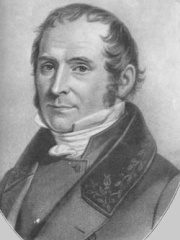
5. Elias Magnus Fries (1794 - 1878)
With an HPI of 69.96, Elias Magnus Fries is the 5th most famous Swedish Biologist. His biography has been translated into 40 different languages.
Elias Magnus Fries (15 August 1794 – 8 February 1878) was a Swedish mycologist and botanist. He is sometimes called the "Linnaeus of Mycology". In his works he described and assigned botanical names to hundreds of fungus and lichen species, many of which remain authoritative today.

6. Carl Peter Thunberg (1743 - 1828)
With an HPI of 69.82, Carl Peter Thunberg is the 6th most famous Swedish Biologist. His biography has been translated into 34 different languages.
Carl Peter Thunberg, also known as Karl Peter von Thunberg, Carl Pehr Thunberg, or Carl Per Thunberg (11 November 1743 – 8 August 1828), was a Swedish naturalist and an "apostle" of Carl Linnaeus. After studying under Linnaeus at Uppsala University, he spent seven years travelling in southern Italy and Asia, collecting and describing people and animals new to European science, and observing local cultures. He has been called "the father of South African botany", "pioneer of Occidental Medicine in Japan", and the "Japanese Linnaeus".

7. Adam Afzelius (1750 - 1837)
With an HPI of 67.45, Adam Afzelius is the 7th most famous Swedish Biologist. His biography has been translated into 28 different languages.
Adam Afzelius (8 October 1750 – 20 January 1837) was a Swedish botanist and an apostle of Carl Linnaeus. Afzelius was born at Larv in Västergötland in 1750. He was appointed teacher of oriental languages at Uppsala University in 1777, and in 1785 demonstrator of botany. In 1793 he was elected a member of the Royal Swedish Academy of Sciences. In 1800, Adam Afzelius became member of the German Academy of Sciences Leopoldina. Between 1792 and 1796, as part of the Sierra Leone Company, he made two journeys to West Africa, where he reported on the geography, climate and natural resources of the region. While there, he also collected botanical specimens that were later acquired by Uppsala University. In 1797–98, he acted as secretary of the Swedish embassy in London and on 19 April 1798, he was elected Fellow of the Royal Society. Returning to Sweden, he again took up his position as botanices demonstrator at Uppsala, and was in 1802 elected president of the "Zoophytolithic Society" (later called the Linnaean Institute). In 1812 he became professor of materia medica at the university. He died in Uppsala in 1837. In addition to various botanical writings, he published the autobiography of Carl Linnaeus in 1823. His brother, Johan Afzelius (1753–1837), was professor of chemistry at Uppsala; and another brother, Pehr von Afzelius (1760–1843; the "von" was added when he was ennobled), who became a professor of medicine at Uppsala in 1801, was distinguished as a medical teacher and practitioner. The botanical genus Afzelia (subfamily Caesalpinioideae) commemorates his name, and in 1857, the plant species Anubias afzelii was named after him by Heinrich Wilhelm Schott. The standard author abbreviation Afzel. is used to indicate this person as the author when citing a botanical name.

8. Carl Linnaeus the Younger (1741 - 1783)
With an HPI of 67.13, Carl Linnaeus the Younger is the 8th most famous Swedish Biologist. His biography has been translated into 25 different languages.
Carl Linnaeus the Younger, Carolus Linnaeus the Younger, Carl von Linné den yngre (Swedish; abbreviated Carl von Linné d. y.), or Linnaeus filius (Latin for Linnaeus the son; abbreviated L.fil. (outdated) or L.f. (modern) as a botanical authority; 20 January 1741 – 1 November 1783) was a Swedish naturalist. His names distinguish him from his father, the pioneering taxonomist Carl Linnaeus (1707–1778).

9. Olaus Rudbeck (1630 - 1702)
With an HPI of 66.61, Olaus Rudbeck is the 9th most famous Swedish Biologist. His biography has been translated into 27 different languages.
Olaus Rudbeck (also known as Olof Rudbeck the Elder, to distinguish him from his son, and occasionally with the surname Latinized as Olaus Rudbeckius) (13 September 1630 – 12 December 1702) was a Swedish scientist and writer, professor of medicine at Uppsala University, and for several periods rector magnificus of the same university. He was born in Västerås, the son of Bishop Johannes Rudbeckius, who was personal chaplain to King Gustavus Adolphus, and the father of botanist Olof Rudbeck the Younger. Rudbeck is primarily known for his contributions in two fields: human anatomy and linguistics, but he was also accomplished in many other fields including music and botany. He established the first botanical garden in Sweden at Uppsala, called Rudbeck's Garden, but which was renamed a hundred years later for his son's student, the botanist Carl Linnaeus.
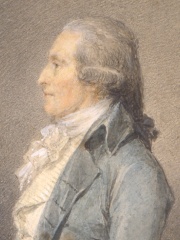
10. Anders Sparrman (1748 - 1820)
With an HPI of 65.71, Anders Sparrman is the 10th most famous Swedish Biologist. His biography has been translated into 23 different languages.
Anders Sparrman (27 February 1748 – 9 August 1820) was a Swedish naturalist, abolitionist and an apostle of Carl Linnaeus.
People
Pantheon has 31 people classified as Swedish biologists born between 1630 and 1955. Of these 31, 2 (6.45%) of them are still alive today. The most famous living Swedish biologists include Tomas Lindahl, and Svante Pääbo. The most famous deceased Swedish biologists include Carl Linnaeus, Hugo Theorell, and Elias Magnus Fries.
Living Swedish Biologists
Go to all RankingsDeceased Swedish Biologists
Go to all RankingsCarl Linnaeus
1707 - 1778
HPI: 90.16
Hugo Theorell
1903 - 1982
HPI: 72.50
Elias Magnus Fries
1794 - 1878
HPI: 69.96
Carl Peter Thunberg
1743 - 1828
HPI: 69.82
Adam Afzelius
1750 - 1837
HPI: 67.45
Carl Linnaeus the Younger
1741 - 1783
HPI: 67.13
Olaus Rudbeck
1630 - 1702
HPI: 66.61
Anders Sparrman
1748 - 1820
HPI: 65.71
Eva Ekeblad
1724 - 1786
HPI: 64.85
Jacob Georg Agardh
1813 - 1901
HPI: 63.76
Erik Acharius
1757 - 1819
HPI: 63.26
Carl Alexander Clerck
1710 - 1765
HPI: 63.01
Overlapping Lives
Which Biologists were alive at the same time? This visualization shows the lifespans of the 25 most globally memorable Biologists since 1700.


